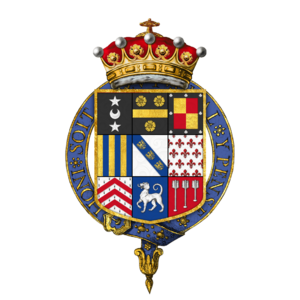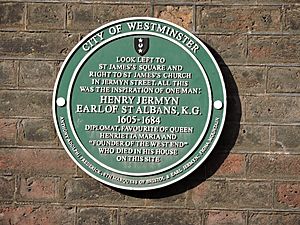Henry Jermyn, 1st Earl of St Albans facts for kids
Quick facts for kids
The Earl of St Albans
|
|
|---|---|

The Earl of St Albans, from a portrait by Lely
|
|
| Lord Chamberlain | |
| In office 1672–1674 |
|
| Monarch | Charles II |
| Preceded by | The Earl of Manchester |
| Succeeded by | The Earl of Arlington |
| Personal details | |
| Born | 1605 |
| Died | 1684 |
| Parents | Sir Thomas Jermyn Catherine Killigrew |
Henry Jermyn, 1st Earl of Saint Albans (born 1605 – died 1684) was an important English politician, diplomat, and courtier. He was a strong supporter of the King during the English Civil War.
Jermyn was a member of the House of Commons (a part of Parliament) for many years. In 1643, he was given the title of Baron Jermyn. He became a close friend and trusted advisor to Henrietta Maria of France, the Queen of England. He worked hard to get foreign countries to help bring back the monarchy (the rule of kings and queens) in England. This was both before and after King Charles I was executed in 1649.
Henry Jermyn always supported friendly relations with France. He became one of the most powerful people at court during the time when England had no king (the Interregnum) and later during the reign of King Charles II.
Contents
Early Life and Travels
Henry Jermyn was born in 1605. He was the second surviving son of Sir Thomas Jermyn, who was an important official for King Charles I. His mother was Catherine Killigrew. Henry was baptised in London on March 25, 1605.
In 1618, when he was about 13, Henry went on a three-year trip around Europe. In 1623, he joined the household of the Earl of Bristol in Madrid, Spain. While living in Spain, he met the Duke of Buckingham. Henry Jermyn was very happy about the kindness and support the Duke showed him.
Becoming a Politician and Courtier
In 1625, even though he was still quite young, Jermyn was elected to Parliament for the area of Bodmin. He was re-elected in 1626. He did not speak much in Parliament during these years. Around 1627, he caught the attention of Queen Henrietta Maria. He was appointed as a gentleman usher in her personal household.
In July 1627, the Queen sent him to France to share her sadness with King Louis XIII after the death of the Duchess of Orléans. In 1628, he became the Queen's vice-chamberlain. That same year, he was elected as a Member of Parliament for Liverpool. When Parliament was not meeting, Jermyn was sent to Jersey to help train the island's local army.
In 1632, Jermyn was sent to Paris again. This time, he congratulated the Queen's mother, Marie de' Medici, on surviving a coach accident. In 1633, his position was put at risk when one of the Queen's ladies-in-waiting had his child. King Charles I sent Jermyn abroad, but he was allowed to return to court in August 1634. His close relationship with Queen Henrietta Maria was not harmed. In 1639, his important role in her household was confirmed when he became her Master of the Horse.
Civil War and Time in Exile
In April 1640, Jermyn was elected to Parliament for Corfe Castle. In November 1640, he was elected again for Bury St Edmunds. He and his brother were strong supporters of the King, known as Royalists. Jermyn was involved in a plan called the First Army Plot in 1641. When the plan was discovered, he had to flee to France.
In 1642, he joined Queen Henrietta Maria in The Hague. He helped her raise money, buy weapons, and find soldiers for the Royalist side. He returned to England in 1643 and continued to serve the Queen. He was made a colonel of her bodyguards. On September 8, 1643, he was given the title of Baron Jermyn of St Edmundsbury. This was so that if he was captured by the Parliamentarian forces, he would face a more honorable death. In the same year, he became a colonel in the King's army. In 1644, he became the Queen's chamberlain. A few months later, he went with Henrietta Maria to France. There, he continued to be her secretary and trusted friend, trying to get support for the Royalist war effort.
In 1645, Jermyn was made Governor of Jersey. He disagreed with Sir Edward Hyde when he brought the Prince of Wales from Jersey to Paris. In 1647, Jermyn advised the King to promise a Presbyterian church in England. This was hoped to gain help from Scotland against Parliament. Before King Charles I was executed in 1649, Jermyn became his ambassador to France and the Dutch Republic. Jermyn supported the alliance between the Royalists and Scotland. This led to the Anglo-Scottish war from 1650 to 1652. In 1651, he was appointed to the Privy Council of England.
In France, Jermyn became a leading figure in the 'Louvre faction'. This was a group of English Royalists who were part of Queen Henrietta Maria's court-in-exile. They were first based at the Louvre Palace. Later, in 1653, the Queen Dowager moved her court to the Palais-Royal. This group was known for being very loyal to Henrietta Maria. They also favored France and opposed the influence of Hyde over Charles II. Jermyn suggested a plan to Charles to give the Channel Islands to France in exchange for military help. Jermyn managed to get large amounts of money from the King's allowance. This allowed him to live quite comfortably, even though the court itself was poor. When Charles went to Breda, Jermyn stayed in Paris with Henrietta Maria. She convinced her son to give Jermyn the title of Earl of St Albans on April 27, 1660.
The Restoration and Later Life
When the monarchy was brought back in England in May 1660, St Albans was given important roles. He was appointed to the Court of Chancery and became a justice of the peace for Suffolk and Middlesex. However, Hyde made sure that Jermyn was kept out of the main government. In 1663, he was present at the birth of James Stuart, Duke of Cambridge.
He served as King Charles II's ambassador to France throughout the 1660s. He strongly supported the idea of friendship with King Louis XIV of France. He played a big part in creating a close, secret agreement between Charles II and Louis XIV. He even helped arrange the first steps of the Secret Treaty of Dover in 1669. St Albans' clear preference for France was a debated topic at court. An Italian diplomat wrote that he was "a man who is wholly devoted to French interests."
St Albans was present when Queen Henrietta Maria died in France in August 1669. He was also in charge of carrying out her will. That same year, he hosted the Grand Duke of Tuscany at his home in London. In 1672, he was appointed Lord Chamberlain, which was the most senior officer in the King's household. He was also made a Knight of the Garter. He briefly served as Lord Chamberlain in the First Danby ministry. He left office in 1674 and mostly retired from public life. In 1683, the year before he died, he was described as "a wise old courtier and much richer since his majesty's return."
Founder of the West End
In September 1662, St Albans received a lease for a large piece of land called Pall Mall Field in London. This land was north of St James's Palace. He began to develop this area by building grand houses in the classical style. This area soon became St. James's Square. The City of London was worried about its water supply and did not like the plan. However, King Charles II supported the development, which stopped any opposition.
The King officially granted the ownership of the new square and other nearby properties to trustees for the Earl of St Albans on April 1, 1665. The Earl of St Albans built his own large house, St Albans House, on the square. It cost him £15,000.
The streets around the square, including Jermyn Street, King Street, Duke Street St James's, and Charles II Street, were finished soon after. This whole area became known as St James's. St Albans market was built on a site that was later cleared for the construction of Regent Street and Waterloo Place. This was a grand plan, and it inspired the development of the entire West End of London. Because of this, Henry Jermyn is known as the 'Founder of the West End'. In the 1660s, he also owned Soho Fields. He leased most of this land to Joseph Girle, who was allowed to develop it.
Personal Life
Henry Jermyn was a friend and supporter of writers like Abraham Cowley and Sir William Davenant. People described St Albans as "an extremely handsome young man." He loved gambling, which was a very popular activity at the time. He also had several romantic relationships at court. A play from 1636, The Platonick Lovers, was dedicated to him.
St Albans died at his house in St James's Square in January 1684. He asked to be buried with his family in Rushbrooke. Since he was never married, his title of Earl of St Albans ended when he died. However, his title of Baron Jermyn and his property passed to his nephew, Thomas Jermyn. In January 1684, right after St Albans' death, King Charles II gave Jermyn's title to one of his own sons, Charles Beauclerk, who became the first Duke of St Albans.
Images for kids






